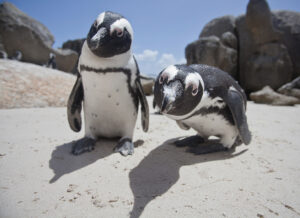A passion for the natural world drives many of our adventures. And when we’re not actually outside, we love delving into the discoveries about the places where we live and travel. Here are some of the best natural history links we’ve found this week.
Mammals Evolved Big Brains After Big Disasters: The relative brain size of mammals has increased over the last 150 million years. Scientists have analyzed the brain mass of 1,400 living and extinct mammals to piece together a timeline of how they have evolved. The biggest changes in brain size occurred after the mass extinction 66 million years ago and a climactic transition 23 to 33 million years ago.
Franklin Sailor Identified From DNA: In 1845, Sir John Franklin’s expedition in search of the Northwest Passage ended in disaster. Both ships became stuck in the ice off King William Island, and all 129 explorers perished. Reports of cannibalism shook England to its core. In the past few years, both sunken ships have turned up in shallow water and in good condition. Now, DNA and genealogical analysis has identified the remains of Warrant Officer John Gregory from bones found on King William Island. He is the first member of the expedition to be identified with this method.

The new species of pumpkin toadlet. Photo: Nunes et al/PLOS
New arrow-poison frog
Pumpkin Toadlet Species Discovered: A new pumpkin toadlet has been discovered in the Atlantic forest along Brazil’s east coast. The tiny new species, Brachycephalus rotenbergae, is the size of a thumbnail, bright orange, and highly poisonous. (Indigenous people dipped the tips of their arrows into an extract from such brightly colored frogs.) Scientists carried out 76 field studies to understand the activity and history of this new species. They found a “curious, visually stunning secret”: The bones close to the surface of the creature’s skin glow under fluorescent light. Although invisible to human eyes, other animals might use them as visual cues.
The Fish that Learned to Live in a Lake: In 1732, the volcanic eruption on Jan Mayen, an island between Norway and Greenland, cut off a small population of arctic char from the ocean. The tasty, red-fleshed fish have lived in tiny Lake Nordlaguna on Jan Mayen ever since. The lake, 1.6km long and 40m deep, has so few food sources that the char have turned on each other. This isn’t the first place where the species have become cannibalistic, and it is starting to change their physiology. “They look like completely different species,” said biologist Lisandrina Mari.
Avalanche of mud
Nunavik Landslide: The April 22 landslide in Nunavik, or northern Quebec, is the second-largest ever in that Canadian province. Spanning an area 1.8km long and 500m wide, the slide dumped 45 million cubic metres of debris into the Great Whale River. Fortunately, local communities were unaffected. Clay soil deposits create “extra sensitive terrain,” explained Laval University geologist Michel Allard, and make this region susceptible to landslides.

Researching heat bombs in the Arctic. Photo: San Nguyen
“Heat Bombs” Under Arctic Sea Ice: Plumes of warm water are flowing into the Arctic Ocean from the Pacific Ocean, causing sea ice to melt from below. These underwater heat bombs partly explain why climate change affects the Arctic more than elsewhere. As the water from the Pacific is saltier than arctic surface water, it is denser. This means that it slips below the surface and creates pockets of warm water that can last for months or years.
28 days under the sea
At the Bottom of the Mediterranean: Four explorers spent 28 days on the sea floor of the Mediterranean to find out more about the creatures dwelling there. The foursome lived in a pressurized barge, breathing a mix of helium and oxygen, and descended to the bottom every day in a diving bell. They then used scuba gear with rebreathers to explore the sea bed for hours at a time.
Bats Know the Speed of Sound from Birth: Bats use sonar to determine an object’s location. This means that they need to decipher the speed of the sound that reflects back to them. Since the discovery of sonar in bats 80 years ago, researchers have wondered whether this skill is innate or learned. By raising bat pups, and enclosing adult bats in an environment with enriched air to increase the speed of sound, researchers have confirmed that they are born with this skill.

The Chinese rocket launch. Photo: bbc.co.uk
Chinese Rocket Falling Back to Earth: Debris from a Chinese rocket will fall back to Earth this weekend. At 18 tonnes, the rocket will be one of the largest objects ever to make an uncontrolled reentry our atmosphere. Modeling experts in space debris are trying to calculate where it will come down, but projections are uncertain. “We’re hopeful that it will land where it won’t harm anyone,” U.S. Defense Secretary Lloyd Austin said. “Hopefully in the ocean, or someplace like that.”
Shark navigation
Sharks use Earth’s Magnetic Field as a Guide: Some species of shark travel long distances to very specific locations. But how do they navigate? One theory suggests that they use magnetic fields since sharks are sensitive to electromagnetism. To test the theory, they exposed sharks to magnetic conditions representing places hundreds of kilometres away. “To be honest, I am surprised it worked,” said project leader Bryan Keller. “The reason this question has been outstanding for 50 years is that sharks are difficult to study.”






